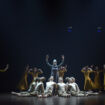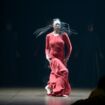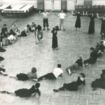In the interview, Brigitta Herrmann and Katharine Sehnert look back on their training with Mary Wigman and talk about their role in the reconstruction of 'Le Sacre du Printemps'.
Addendum…
By: Brigitta Herrmann
Date: 31 May 2013
To: Isabel Niederhagen
Subject: Interview
Hello Isabel,
A few things have come to mind that I didn’t think of in the interview. That’s a shame, so I’m writing to you to add them now.
Wigman’s influence in Philadelphia is very big, although the city and her name are rarely linked. You could even say that Philadelphia is a kind of Wigman stronghold, as Hellmut Gottschild and I taught for many years there and worked as choreographers with a group. Our work brought generations of dancers into contact with Wigman’s movement material and philosophy; we taught movement qualities and the way Wigman’s used space and linked dance and music is still visible today.
Hellmut taught for 30 years or more at Temple University. I first ran the Group Motion Company with him and taught later at the Philadelphia College for the Performing Arts (around 1970–83). I also taught at the University of Pennsylvania and at Naropa University. Hellmut left Group Motion and founded a new company – the Zero Moving Dance Company – in 1970.
As a result of our work together, my partner Manfred Fischbeck was familiar with Wigman. He joined the Group Motion Company in 1967. It was originally founded in Berlin and moved to Philadelphia in 1968.We developed the group’s multi-media concepts together in the USA and were artistic directors of the group until 1989.
Although Manfred was more improvisational than technique-based in his work and teaching, you can still see certain Wigman elements in his artistic work. After we split in in 1989, he became sole artistic director of the Group Motion Company.
Another Mary Wigman influence came via Heddy Tower. Heddy came from Dresden and was a Wigman student in the 1930s. She left Germany in the mid-1930s because she was Jewish. A later colleague of mine, Michael A. Carson, had taken lessons with her for several years in an amateur dance course. He found out about me and my Wigman background through her. He came to my studio, took part in my workshops and we worked for several years together.
We partly ran our new group, AUSDRUCKSTANZ DANCE THEATER (1989–2002), together. We opened a studio in Philadelphia and put together a Mary Wigman exhibition with extracts from Wigman’s writings as well as photos. I gave my lecture on Mary Wigman regularly for several years.
I could still say a lot more about my beginnings and my work. I have been working for 50 years now, during which time I have created more than 80 group and solo choreographies.
Warm wishes,
Brigitta Herrmann
KATHARINE SEHNERT
Katharine trained with Mary Wigman in Berlin. She was a co-founder of the independent dance group Motion Berlin. After working as an assistant for Pina Bausch at the Folkwang Tanzstudio Essen, she founded the group Mobile Frankfurt in 1976.In 1978, she won the international choreographer competition Bagnolet.
In 1982, she opened TANZRAUM Cologne, and in 1986 the group Kontinuum Cologne emerged. In 1994, she became the first winner of the Cologne Dance Prize. Guest performances took her to Mexico and the USA, for example. In addition to her work as a dancer and choreographer, she regularly gives university seminars and gives lectures about Mary Wigman. She was also an artistic advisor for Fabian Barba’s re-enactment project A Mary Wigman Evening. In 2009, she received the Honorary Theatre Prize from the City of Cologne for her life’s work.
BRIGITTA HERRMANN
Brigitta was born in Weimar and trained with Mary Wigman in Berlin. She is a co-founder of the independent dance group Motion Berlin, the Group Motion Multi Media Dance Theater as well as theAusdruckstanz Dance Theater in Philadelphia. She has created more than 70 pieces in 50 years. She has received numerous scholarships and presented her work in both the USA and Europe.











